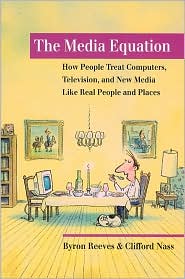Comment #1
Comment #2
Comment #3
The Media Equation
Byron Reeves & Clifford Nass
Summary:
This book discusses research that was made to understand the interactions that take place between humans and media. The authors claim, "We have found that individuals' interactions with computers, television, and new media are fundamentally social and natural, just like interactions in real life." This is the basis of the "media equation," media = real life.
The authors explore areas such as media and manners, personality, emotion, social roles, and form. They claim that social interactions that take place every day between people also apply to forms of media. The experiments involve first finding a rule describing peoples' responses to each other or to their natural environment. Then, the rule is adapted to include media. For instance, "people who like other people who flatter them" becomes, "people will like computers that flatter them." An experiment is then conducted to prove or disprove this assumption.
Discussion:
Overall, I thought the book was fairly interesting and though-provoking. In my opinion, the second half of the book was better than the first, because the authors didn't go into as much detail about how the experiments were conducted. More time was spent analyzing the results and discussing their conclusions.
As for their conclusions, I believe that some of them might be a stretch. Occasionally, it seems that they disregarded some issues/factors in their experiments when analyzing their results. One instance in particular concerned the programmers in their experiment on "politeness" (this subject was beaten to death in class, so I won't discuss it again). Other good points were discussed in class about the memory of disturbing things vs. the memory of everyday things. The authors should have tried to address some of these issues.
The results of an experiment don't necessarily guarantee anything. Results can be interpreted many different ways by the person performing the experiment. Issues or problems with the experiment which might have affected the results may be discovered. Instead of automatically disregarding these issues, the experiment should be refined so its results are less ambiguous or refutable.
These issues aside, I thought the book was decent and raised some interesting issues. As they mentioned, these results can be applied in many different areas such as making advertisements more memorable and making software more enjoyable to use.
Ranking:
#1- The Design of Everyday Things
#2- The Media Equation


6 comments:
It's true that the authors went into way to much detail in the first half, making it a fairly boring read. I agree that you can use this information to improve software, just by knowing the fundamental physcology behind how humans interact with computers.
I think one important part you brought up was that just because you do A and then B happens does not mean that A causes B. Courses in statistics talk about this all of the time. It is important to realize that their could be some outside source C that causes both A and B. They did not seem to address this a lot.
Brian did a good job of singling out an excellent point you made in this post. While there are a number of the topics covered in the book were interesting and pertinent, the experiments felt weakly based and could mean a wildly different thing given another interpretation of the results.
I can go along with the fact that some of their experiments could be interesting. But their discussion of those experiments was terrible. I feel like if you sat in on our class, gave us the experiment results, and wrote down what we said, you would have a better book on your hands.
There were definitely too many details on the experiments. I guess they need the details to show that their experiments aren't biased, but they can put the details in a research paper or something. The book should just contain the interesting stuff. I agree that some of the conclusions were a stretch. Some of the conclusions didn't even tell use anything we didn't already know.
I agree with Brian - they didn't do much to disprove potentially causal relationships, which, in my opinion, hurt the credibility of the book. The experiments weren't so well designed that they were beyond scrutiny.
Post a Comment